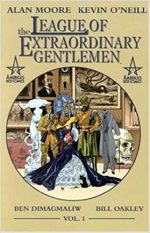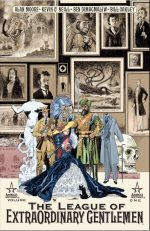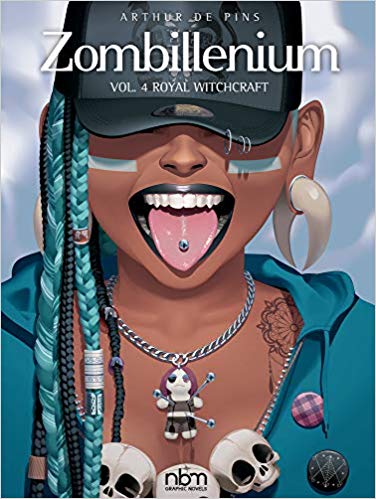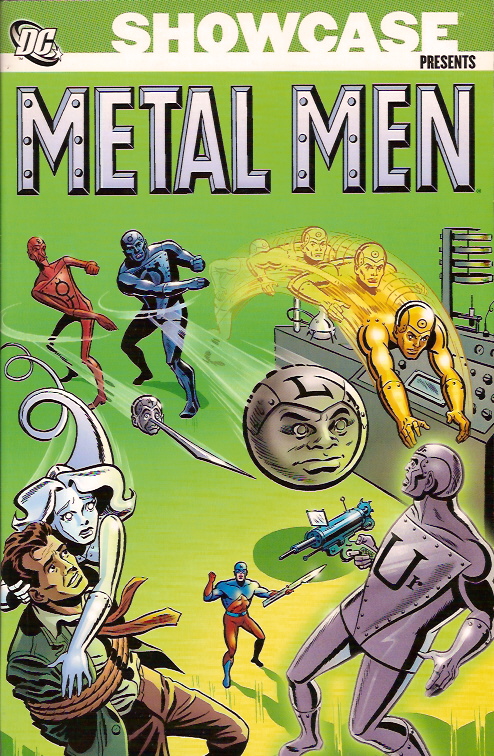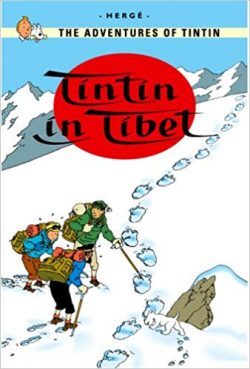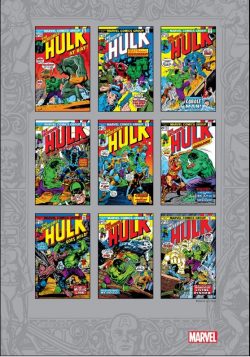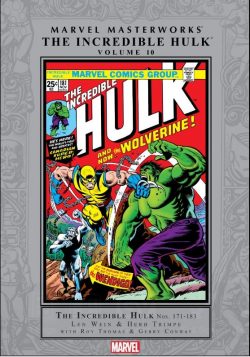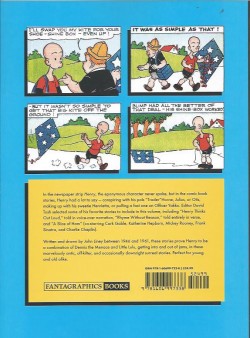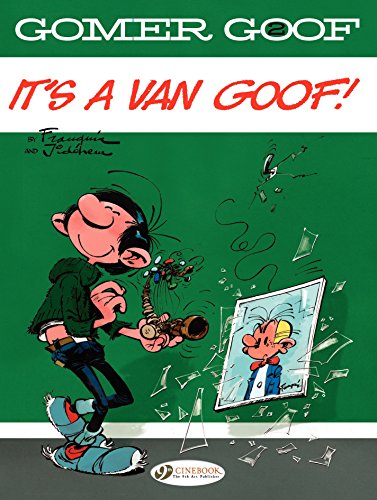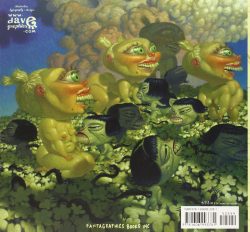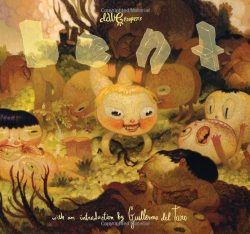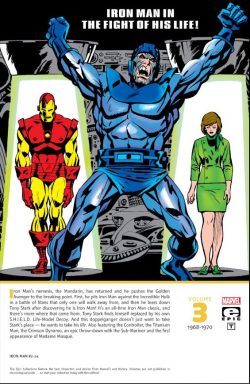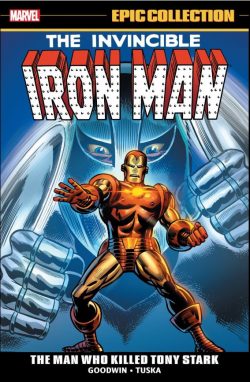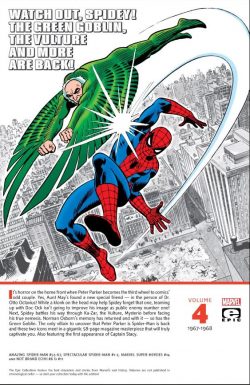
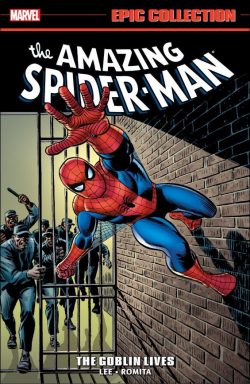
By Stan Lee, Gary Friedrich, Arnold Drake, John Romita, Don Heck, Jim Mooney, Ross Andru, Larry Lieber, Marie Severin & various (Marvel)
ISBN: 978-1-3029-1780-7 (TPB)
Amazing Spider-Man was always a comicbook that matured with – or perhaps just slightly ahead – of its fan-base. In this superbly scintillating compilation of chronological webspinning wonderment, the World’s Most Misunderstood Hero survives another rocky period of transformation as the second great era of Amazing Arachnid artists moved inevitably to a close. Although the elder John Romita would remain closely connected to the Wall-Crawler’s adventures for a little time yet, these tales would be amongst his last sustained run as lead illustrator on the series.
After a shaky start, The Amazing Spider-Man quickly became a popular sensation with kids of all ages. Before too long the quirky, charming, thrillingly action-packed comics soap-opera would become the model for an entire generation of younger heroes impatiently elbowing aside the staid, (relatively) old thirty-something mystery-men of previous publications and hallowed tradition.
You know the story: Peter Parker was a smart-but-alienated kid bitten by a radioactive spider during a school science trip. Discovering he’d developed astonishing arachnid abilities – which he augmented with his own natural chemistry, physics and engineering genius – the kid did what any lonely, geeky nerd would do with such newfound prowess: he tried to cash in for girls, fame and money.
Making a costume to hide his identity in case he made a fool of himself, Parker became a minor media celebrity – and a criminally self-important one. To his eternal regret, when a thief fled past him one night he didn’t lift a finger to stop him, only to find when he returned home that his guardian uncle Ben Parker had been murdered.
Crazed and vengeful, Peter hunted the assailant who’d made his beloved Aunt May a widow and killed the only father he had ever known, discovering, to his horror, that it was the self-same felon he had neglected to stop. His irresponsibility had resulted in the death of the man who raised him, and the traumatised boy swore to forevermore use his powers to help others…
Since that night, the Wondrous Wallcrawler tirelessly battled miscreants, monsters and madmen, with a fickle, ungrateful public usually baying for his blood even as he perpetually saves them…
The rise and rise of the Amazing Arachnid increased pace as the Swinging Sixties drew to a close. By the time of the tales collected in this fulsome, full-colour Epic Collection (available in ponderous paperback or ephemeral eBook formats and re-presenting Amazing Spider-Man #53-67, spurious spoofs from parody mag Not Brand Echh #6 and 11, plus an obscure thriller from Marvel Super-Heroes#14, and cumulatively spanning October 1967 to December 1968 and the usual basket of editorial extras), Peter and his ever-expanding cast of comrades were on the way to being household names as well as the darlings of college campuses and the media intelligentsia.
Stan Lee’s scripts were completely in tune with the times – as understood by most kids’ parents at least – and the increasing use of soap opera plots kept older readers glued to the series even if the bombastic battle sequences didn’t.
Thematically, there’s still a large percentage of old-fashioned crime and gangsterism and an increasing use of mystery plots. Dependence on costumed super-foes as antagonists was finely balanced with the usual suspect-pool of thugs, hoods and mob-bosses, but these were not the individual gangs of the Ditko days.
Now Organised Crime and Mafia analogue The Maggia were the big criminal-cultural touchstone as comics caught up with modern movies and headlines.
A multi-part saga began in #53 with ‘Enter: Dr. Octopus’, wherein the many-tentacled madman tries to steal a devastating new piece of technology. After being soundly routed, Otto Octavius goes into hiding as a lodger at Aunt May’s house in ‘The Tentacles and the Trap!’, before regrouping and finally triumphing in ‘Doc Ock Wins!’
The madman even convinces a mind-wiped webslinger to join him before the astonishing conclusion in ‘Disaster!’ as, despite being bereft of memory, the wallcrawler turns on his sinister subjugator and saves the day…
Shell-shocked and amnesiac, Spider-Man is lost in New York in #57 (with lay-outs by Romita and pencils from the reassuringly reliable Don Heck) until he clashes with Marvel’s own Tarzan analogue in ‘The Coming of Ka-Zar!’, whilst in the follow-up ‘To Kill a Spider-Man!’, vengeance-crazed roboticist Professor Smythe again convinces J. Jonah Jameson to finance another murderous mechanical Spider-Slayer and hunt down his personal bête noir…
With Heck still in the artist’s chair, Amazing Spider-Man #59 sees the hero finally regain his memory and turn his attention to a wave of street-crime in ‘The Brand of the Brainwasher!’ Here a new mob-mastermind starts taking control of the city by mind-controlling city leaders and prominent cops – including Police Captain George Stacy, the father of Peter Parker’s girlfriend Gwen…
The tension builds as the schemer is revealed to be one of Spidey’s old foes in ‘O, Bitter Victory!’ This revelation creates even bigger problems for Peter and Gwen before concluding chapter ‘What a Tangled Web We Weave…!’ sees our hero save the day but still stagger away more victim than victor …
Amazing Spider-Man #62 declaimed ‘Make Way for …Medusa!’ as Lee, Romita, Heck & Mike Esposito supplied a fresh change-of-pace yarn with the webspinner stumbling into combat with the formidable Inhuman due to the machinations of a Madison Avenue ad man.
Spider-Man’s popularity led to Marvel attempting to expand his reach to older readers via the magazine market.
July 1968 saw the launch of Spectacular Spider-Man #1 by Lee, John Romita & Jim Mooney: a lengthy political thriller with charismatic reformer Richard Raleigh ferociously campaigning to become Mayor. The run results in his being targeted and hunted by a brutish monster seemingly determined to keep the old political machine in place at all costs…
Rendered in moody wash tones, the drama soon discloses a sinister plotter behind the campaign of terror… but his identity was the last one Spidey expected to expose…
Also included was a retelling of the hallowed origin tale ‘In the Beginning…’ by Lee, with Larry Lieber pencils and inks-&-tones added by the great Bill Everett.
Back in the four-colour world, Amazing Spider-Man #63 saw the original elderly Vulture return to crush his youthful usurper Blackie Drago in ‘Wings in the Night!’ before taking on Spidey for dessert.
The awesome aerial assaults concluded with carnage on the city’s highest buildings in ‘The Vultures Prey’ leading to another art-change (with the sumptuous heavy line-work of Jim Mooney briefly replacing the workmanlike Heck & Esposito) in #65 as a wounded Spider-Man is arrested and has to engineer ‘The Impossible Escape!’ from a Manhattan prison, incidentally foiling a mass jailbreak along the way.
A psychotic special-effects mastermind returns seeking loot and vengeance in #66’s ‘The Madness of Mysterio!’ (Romita, Heck & DeMeo) as the master of FX illusions engineers his most outlandish stunt, whilst in the background amnesiac Norman Osborn slowly regains his memory.
Although the wallcrawler is subjected to a bizarre form of mind-bending it nevertheless results in an all-out action-packed brawl (rendered by Romita & Mooney) entitled ‘To Squash a Spider!’. Perhaps more interestingly, this yarn introduces Randy Robertson, college student son of the Daily Bugle’s city editor and one of the first young black regular roles in Silver Age comics.
Lee and his staff were increasingly making a stand on Civil Rights issues at this time of unrest and Marvel would blaze a trail for African American and other minority characters in their titles. There would also be a growth of student and college issues during a period when American campuses were coming under intense media scrutiny…
The magazine experiment then concludes with The Spectacular Spider-Man #2 (November 1968). To offset disappointing sales, Marvel had abruptly switched to a smaller size and added colour, but it was to be the last attempt to secure older-reader shelf-space until the early 1970s. At least the story was – and remains – top-rate…
Following monochrome recap ‘The Spider-Man Saga’ Lee, Romita & Mooney deal with months of foreshadowing by finally revealing how Norman Osborn shakes off his selective amnesia and returns to full-on super-villainy in ‘The Goblin Lives!’
Steeped in his former madness and remembering Peter Parker is Spider-Man, Osborn plays cat and mouse with his foe, threatening all the hero’s loved ones until a climactic battle utilising hallucinogenic weapons again erases the Goblin personality… for the moment…
Closing the drama division of this colossal comics compendium is a one-off yarn from Marvel Super-Heroes #14 (May 1968).
‘The Reprehensible Riddle of the… The Sorcerer!’ reads to me like an inventory tale rushed out to fill a deadline gap or printed just before its “use-by†date expired. Nonetheless, as crafted by Lee, Ross Andru & Bill Everett, it offers an enticingly different spin on the wallcrawler with an enigmatic psychic targeting Spider-Man using psionic strikes and voodoo tricks to draw the hero to New Orleans and a death duel with a synthetic, science-tinged homunculus…
Always fond of a giggle himself, the hero was a regular star of comedy vehicle Not Brand Echh. All romance issue #6 (February 1968) featured Gary Friedrich & Marie Severin’s ‘With This Ring, I Thee Web!’ as the young man pursues his destined true love only to suffer a tragic loss, whilst December’s #11 provided a trenchant fable decrying success and merchandising in Arnold Drake, Severin & John Tartaglione’s ‘Fame is a Cross-Eyed Blind Date with B-a-a-a-d Breath!’
Also on show are a wealth of art treats including original art and production photostats; unused pencil pages by Romita and Lieber; sketches and painted magazine covers by Harry Rosenbaum and Romita; house ads; character sketches and notes, and reproductions of earlier collection covers by Romita & Dean White.
Spider-Man became a permanent unmissable part of many teenagers’ lives at this time and did so by living a life as close to theirs as social mores and the Comics Code would allow. Blending cultural authenticity with glorious narrative art, and making a dramatic virtue of the awkwardness, confusion and sense of powerlessness most of the readership experienced daily, resulted in an irresistibly intoxicating read, delivered in addictive soap-opera slices, but none of that would be relevant if the stories weren’t so compellingly entertaining.
This book is Marvel and Spider-Man at their peak. Why not see why…?
© 1968, 2019 Marvel. All rights reserved.

